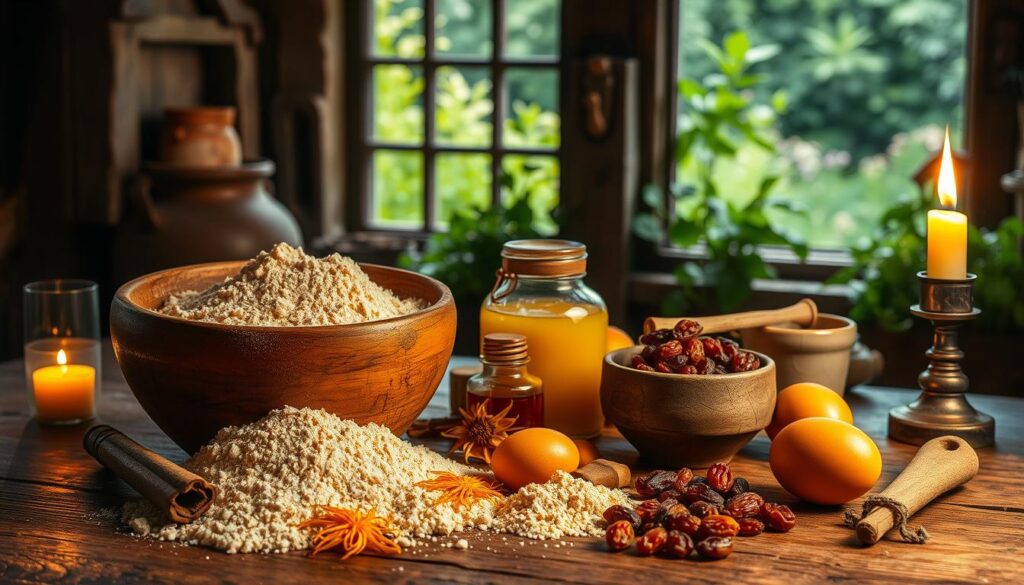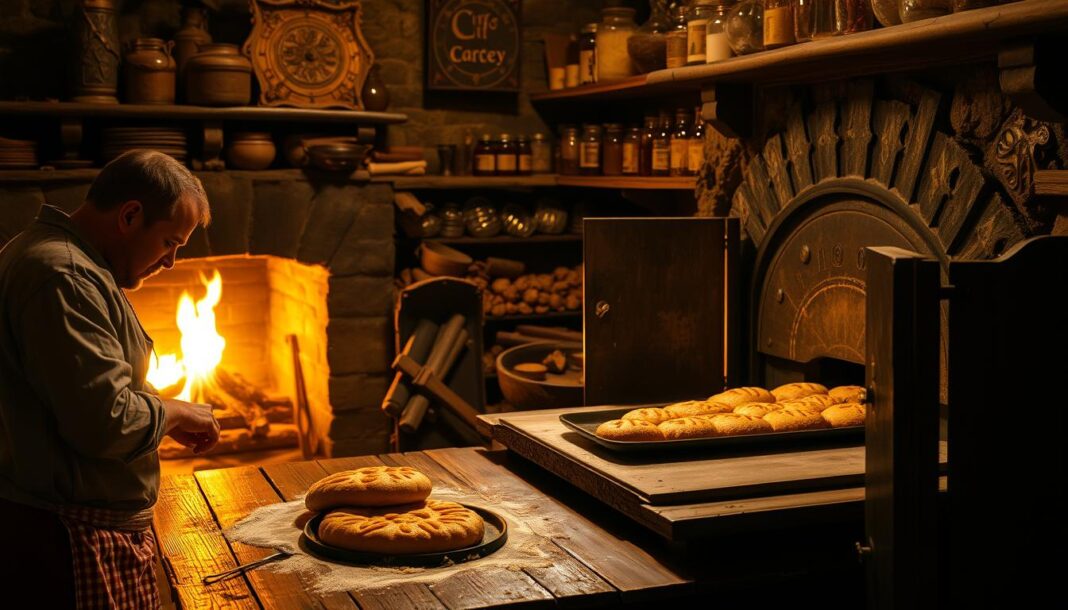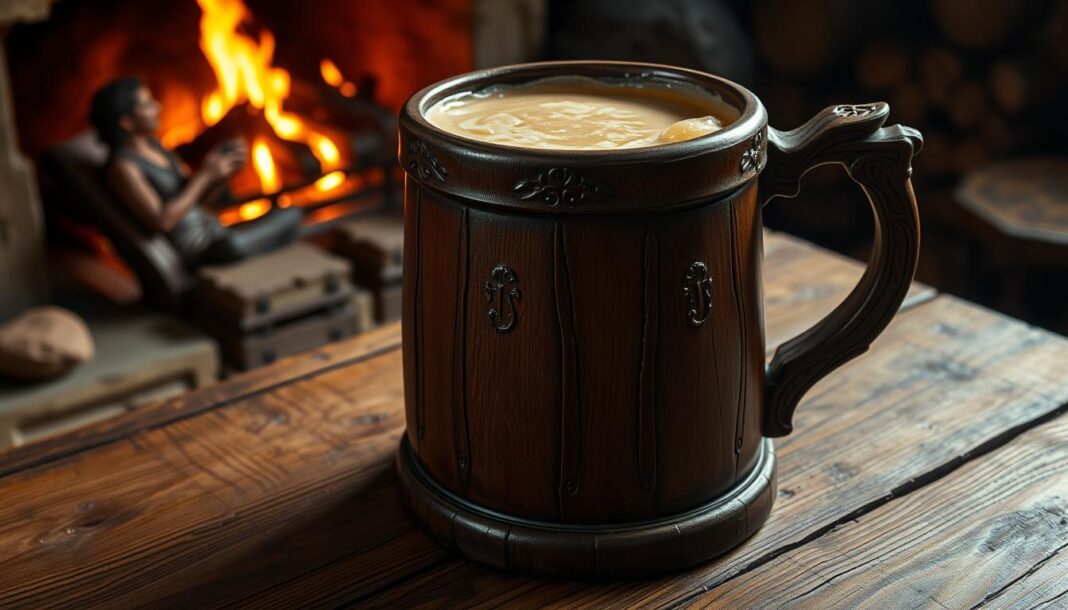Exploring the world of historical baking, we discover that medieval cakes were far denser and less sweet than their modern counterparts. This difference is largely due to the limited availability of ingredients and varying cooking techniques used at the time.
As we journey through these historical recipes, we gain insight into the evolution of baking methods while preserving traditional flavors. By examining authentic recipes, we can appreciate the ingenuity of historical cooks and adapt their techniques for today’s kitchens.
Understanding how cake preparation has changed over centuries not only highlights the advancements in food technology but also showcases the cultural practices and celebrations that shaped these special cakes.
Key Takeaways
- Medieval cakes were denser and less sweet due to limited ingredient availability.
- Historical baking methods have evolved significantly over time.
- Authentic medieval recipes offer insights into past culinary practices.
- Modern baking can be influenced by historical techniques and ingredients.
- Cultural celebrations and practices shaped traditional cake recipes.
The Rich History of Medieval Cakes
The story of medieval cakes is one of cultural exchange, culinary innovation, and tradition. As we explore the history of cakes, we find that they have been an integral part of human culinary practices for thousands of years, evolving significantly over time and across different cultures.
Origins of Sweet Treats in the Middle Ages
The history of cake as a food item stretches back thousands of years. The earliest cakes were probably made from mashed legumes and honey in the ancient Near East. The ancient Egyptians made light cakes from honey-sweetened yeast dough, while the Romans baked barley loaves with honey, raisins, pine nuts, and pomegranate seeds. The influence of Arab confectionery played a crucial role in spreading honey cakes throughout Europe, particularly through Spain and Sicily.
From Ancient Egypt to Medieval Europe
The journey of cakes from ancient civilizations to medieval Europe was marked by significant cultural exchange. The Arabs were instrumental in introducing honey-based cake recipes to Europe. By the start of the 11th century, Italians were baking dense cakes from honey and bread crumbs, a tradition that was further carried forward by Italian Jews to central and western Europe.
The Influence of Arab Confectionery
Arab confectioners brought their expertise in creating sweet treats to Spain and Sicily, significantly influencing the development of cakes in medieval Europe. Their introduction of honey-based recipes laid the groundwork for the diverse range of cakes that became integral to medieval culinary traditions.
Cultural Significance of Medieval Cakes
Medieval cakes were not just a form of sustenance; they played a significant role in various ceremonial aspects of medieval life. From religious celebrations to important life milestones, cakes were an integral part of the cultural fabric.
Ceremonial Uses in Medieval Society
Cakes were used in various ceremonies, symbolizing different aspects of medieval life. They were served during religious celebrations and important life events, highlighting their significance in medieval society.
The Aleph-Bazyn Tradition
The Aleph-Bazyn was a charming ceremony held by medieval Ashkenazim for little boys on their first day of school. A honey cake bearing inscriptions from Prophets and Psalms was served, symbolizing the association of learning with sweetness. For more on medieval cakes and their significance, visit our page on medieval cakes and explore the history of honey cakes.
| Culture | Cake Tradition | Significance |
|---|---|---|
| Ancient Egypt | Honey-sweetened yeast dough cakes | Ritual and ceremonial use |
| Arab | Honey-based cake recipes | Introduced to Europe through Spain and Sicily |
| Medieval Europe | Dense cakes made from honey and bread crumbs | Ceremonial and celebratory purposes |

We have explored the rich history of medieval cakes, tracing their origins, cultural significance, and the influence of various cultures on their development. The story of medieval cakes is a testament to the power of culinary traditions in shaping our cultural heritage.
Authentic Medieval Cake Ingredients
To truly understand medieval cakes, we must first examine the ingredients that defined their character. The medieval period was marked by limited access to certain ingredients, particularly sugar, which significantly influenced the nature of their cakes.
Sweeteners Before Sugar
Before the widespread availability of sugar, medieval bakers relied heavily on alternative sweeteners. Honey was the primary sweetener used in medieval cake recipes, giving cakes a distinctive flavor profile.
Honey as the Primary Sweetener
Honey served as the cornerstone of sweetness in medieval baking. It was used not only for its sweetness but also for its preservative qualities. Medieval bakers would often use honey to create a rich, dense cake that could last for several days.
Fruit and Natural Sweeteners
In addition to honey, medieval bakers utilized various fruits and natural sweeteners to enhance their cake mixture. When honey was scarce, fruits like dates and figs were used to add sweetness to cakes. This practice not only varied the flavor but also made the cakes more accessible.
Flours and Grains of the Middle Ages
The type of flour used in medieval baking was another critical factor that differentiated their cakes from modern ones. “Fine flour” was a term used to describe the most refined flour available at the time, though it was still coarser than modern cake flour.
Types of Medieval Flour
Medieval flour varied significantly in quality and texture, depending on the grain used. Wheat flour was a luxury reserved for the wealthy, while common people used barley, rye, or mixed grain flours for their cakes. For more information on medieval baking, you can visit our page on honey cake recipes.
The Absence of Modern Leavening Agents
Unlike modern baking, medieval cakes lacked leavening agents like baking powder or baking soda. Instead, they relied on eggs, ale barm (yeast), or air incorporated during mixing to provide rise. This resulted in cakes that were often dense and flat compared to today’s standards.

Recreating a Traditional Medieval Honey Cake
Medieval honey cakes offer a glimpse into the past, revealing the simplicity and richness of ancient baking techniques. To recreate these historical desserts, we must first understand the challenges and processes involved in interpreting medieval recipes.
Decoding Historical Recipes
Decoding historical cake recipes presents unique challenges, as medieval cooking instructions were often vague, assuming the cook already possessed basic knowledge of techniques and proportions. For instance, a medieval recipe might state, “The cake is prepared from three measures of fine flour… one mixes into it honey, oil, and milk.” This lack of specificity requires us to make educated interpretations.
Interpreting Vague Medieval Instructions
Medieval recipes often lacked detailed instructions, making it necessary for modern bakers to fill in the gaps based on historical context and culinary knowledge. As noted in historical culinary resources, such as those found on Getty’s Iris blog, understanding these historical contexts is crucial.
Understanding Medieval Measurements
Medieval measurements, like “three measures of fine flour,” require interpretation for modern cooking, as they don’t translate directly to our standardized cups and teaspoons. We have to research and estimate these measurements to recreate an authentic recipe.
Step-by-Step Medieval Honey Cake Recipe
Our reconstructed recipe for medieval honey cake uses 3 cups of cake flour, 1 cup of honey, ½ cup of oil, and ½ cup of milk to create an authentic mixture that resembles the original. To begin, preheat your oven to 350°F and line a 9-inch round cake pan with parchment paper, a modern adaptation of medieval baking techniques.
Ingredients and Preparation
Mix together flour and honey until reasonably combined. Then, mix in the oil, followed by the milk, until the batter achieves a consistency similar to Play-Doh. This process requires patience and a bit of trial and error to get right.
Baking Techniques and Serving Suggestions
Spread the batter into the prepared pan, smoothing with a spatula. Bake for 35-40 minutes, or until the cake is done. The cooking time is an educated estimate based on the density of the cake and modern oven temperatures. This cake is best served warm, enhancing its aromatic qualities and providing the best taste experience.

By following this recipe, we can experience the flavors and textures of medieval baking, connecting us to the past in a tangible way. The resulting cake has a dense, scone-like texture, reflecting the authentic medieval experience.
Adapting Medieval Baking for Modern Kitchens
Adapting medieval recipes for today’s kitchens involves balancing historical authenticity with contemporary tastes. We achieve this by merging traditional medieval baking techniques with modern ingredients and cooking methods.
For special occasions like birthday celebrations, we can create medieval-inspired castle cakes using modern ingredients such as chocolate frosting, sugar cones, and KitKat bars. These elements help represent traditional castle features in a way that’s both authentic and appealing to modern palates.
Modern baking techniques allow us to craft layered cakes with decorative edges that would have been impossible in medieval times. Yet, these creations capture the essence of medieval architecture and aesthetics, making them perfect for themed parties or educational events.
When adapting medieval recipes, substituting refined sugar for part of the honey can create a more familiar sweetness profile while honoring the original concept. The creative use of modern ingredients like chocolate can transform a simple cake into an impressive medieval-inspired centerpiece.
The bottom layer of adapted medieval castle cakes typically forms the foundation, with additional layers and decorative elements added to the top to create height and visual interest. Corner towers made from sugar cones or cookies add architectural authenticity to castle cake designs, connecting modern baking with historical references.
For those planning medieval-themed events, preparing components in advance and assembling the final cake closer to the celebration time ensures freshness while managing the cooking process more efficiently. Using parchment paper, a modern baking aid, helps with removing cakes cleanly from pans—a challenge medieval bakers would have faced with their primitive cooking vessels.
These adapted recipes can be prepared a week in advance of special occasions, with certain elements stored separately until final assembly. This approach makes them practical for busy modern households while still offering a side of history with dessert.


